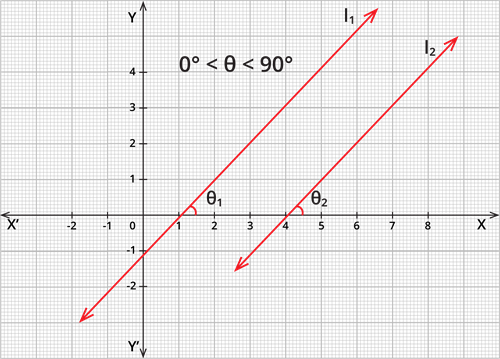
PUMPA - SMART LEARNING
எங்கள் ஆசிரியர்களுடன் 1-ஆன்-1 ஆலோசனை நேரத்தைப் பெறுங்கள். டாப்பர் ஆவதற்கு நாங்கள் பயிற்சி அளிப்போம்
Book Free DemoLet l_1 and l_2 be two non-vertical lines.
The slope of line l_1 is m_1, and line l_2 is m_2.
Let the inclination of l_1 be \theta_1 and l_2 be \theta_2.
Assume l_1 and l_2 are parallel lines.

If two lines are parallel, then their corresponding angles are equal.
\Rightarrow \theta_1 = \theta_2
\Rightarrow \tan \theta_1 = \tan \theta_2
\Rightarrow m_1 = m_2
The slopes are equal.
Conversely:
Assume slopes of two lines l_1 and l_2, are equal.
\Rightarrow m_1 = m_2
\Rightarrow \tan \theta_1 = \tan \theta_2
\Rightarrow \theta_1 = \theta_2
\Rightarrow Corresponding angles are equal.
\Rightarrow l_1 and l_2 are parallel.
Thus, the non-vertical lines are parallel if and only if their slopes are equal.
If two lines are parallel, then their slopes are equal. That is, m_1 = m_2.
Example:
If a line p passing through the points (1, 8) and (2, 13) and a line q passing through the points (0, -1) and (1, 4) are parallel?
Solution:
Let the points passing through the line p be A = (1, 8) and B = (2, 13).
And, the points passing through the line q be C = (0, -1) and D = (1, 4).
Two lines are parallel if their slopes are equal.
Let us find the slopes of p and q.
Slope =
Slope of p =
Slope of q =
Hence, the slope of p = slope of q.
Therefore, the lines p and q are parallel.
Important!
The quadrilateral is a parallelogram if the slopes of both pairs of opposite sides are equal.